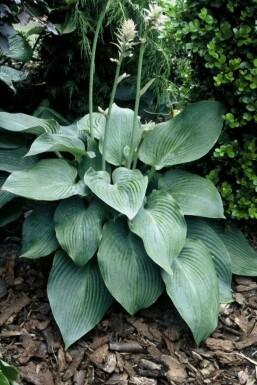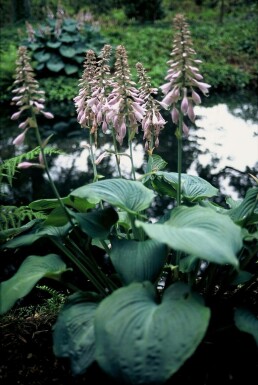

90cm



The Hosta, often referred to as the plantain-lily, is a genus prized for its lush foliage. With leaves that exhibit an array of colors, including blue, green, grey, yellow, and white, Hostas serve as a delightful ground cover or as an accent in shaded garden areas. Native to Japan, these perennial plants are known for their durability and their ability to flourish in a variety of garden settings. The Hosta's elegant purple or white flowers add a subtle charm to its already attractive leafy display, ensuring a serene and sophisticated addition to any landscape design.


90cm





100cm






50cm












50cm





















The genus Hosta, commonly known as plantain-lilies, offers a diverse palette of foliage and a serene beauty to any garden space. Hostas are cherished for their lush leaves that come in an array of colors, from the deepest of greens to the brightest of yellows. Originally hailing from Japan, these robust perennials are a gardener's delight for their adaptability and aesthetic appeal.
Hostas are a versatile group of plants that can thrive in a variety of settings, from the dappled shade of a woodland border to the sunnier spots of a well-kept garden. Here are some key features that make Hostas a must-have:
To ensure your Hostas remain vibrant and healthy, consider the following tips:
With these considerations in mind, Hostas can be a delightful addition to your garden, offering both simplicity in care and complexity in beauty. Whether you are an experienced gardener or a novice, Hostas will not disappoint with their enduring charm and grace.
Embrace the serene beauty of Hosta, commonly known as plantain-lily, which offers a lush tapestry of foliage to any garden. Renowned for their elegant leaves that come in a variety of shapes, sizes, and hues, these perennials provide a textured backdrop or a stunning focal point in shade gardens. Their resilience and graceful presence make them a cherished addition for gardeners seeking a touch of tranquility and verdant splendor.
We would like to provide some tips on how to plant and care for a Hosta. By following these tips, you can be sure to enjoy your Hosta for a long time.
The ideal location for this species offers partial shade to full shade, where the delicate foliage is protected from the harsh afternoon sun. While Hostas can tolerate some sunlight, their leaves may scorch if exposed to prolonged direct sunlight, especially in hotter climates. They flourish in a sheltered spot that receives dappled light, thus accentuating their striking foliage colors, which range from blue and green to yellow and variegated patterns. These plants prefer well-drained soil to prevent waterlogged conditions, which can impede their growth and health.
To plant this species, select a location with well-drained soil that can accommodate its breadth, as it thrives in conditions ranging from partial shade to full shade, although some varieties can tolerate sun. Planting in the spring allows the plant to establish itself before the high heat of summer. When planting a Hosta, dig a hole as deep as the pot and twice as wide, backfilling gently to avoid air pockets. Water the plant thoroughly to settle the soil around the roots and ensure consistent moisture, especially during dry periods, to support healthy growth.
For optimal growth and vibrant foliage, fertilizing is key. It's recommended to fertilize twice during the growing season. The first application should be in the early spring, as new growth appears. The second application can be made mid-summer to encourage continued vigor, especially before the flowering period.
A balanced, slow-release fertilizer is ideal, as it provides a steady supply of nutrients. This is particularly beneficial for Hosta, ensuring that the impressive range of foliage colors—from blue and green to grey and yellow—remains vivid throughout the growing season. Additionally, a well-fed plant tends to have a more robust constitution, which can be advantageous in shaded garden areas where these plants thrive. Always follow the manufacturer's instructions for application rates to prevent over-fertilization, which can be detrimental to the plant's health.
Hostas are a gardener's delight due to their minimal maintenance requirements, especially when it comes to pruning. These resilient perennials do not require regular pruning; their care is primarily focused on removing spent flower stalks to maintain a tidy appearance. As autumn progresses, one may choose to clear away dead or damaged foliage to prepare for the plant's dormancy period. This simple act helps to keep the garden looking neat throughout the colder months and ensures the Hosta emerges healthy and vibrant come spring.
The species thrives with consistent moisture, especially during the warmer months when it is actively growing. While it has an average water need, it's crucial to ensure the soil remains well-drained to prevent waterlogging. Inadequate hydration, particularly in locations with full sun, can lead to stress on the plant. Therefore, maintaining a regular watering schedule that deeply soaks the soil will promote a robust root system and vibrant foliage. It's advisable to water in the morning to allow leaves to dry, reducing the potential for foliar issues.
Hosta varieties are admired for their lush foliage, with leaves that range from deep greens to variegated patterns. These perennials thrive in shady spots where other plants might struggle, making them excellent choices for adding texture and color under canopies. To preserve their stunning foliage, ensure adequate space between each plant for air circulation. As a bonus, Hostas are known to become more impressive with age, their clumps expanding to showcase their striking leaves more prominently with each passing season.
For optimal health and growth, division of Hosta is beneficial, encouraging rejuvenation and allowing gardeners to manage plant size. This process is ideally undertaken in spring or autumn when the plant is not in active bloom. To divide, gently lift the entire plant from the soil, ensuring a substantial root ball is intact. Using a sharp knife or spade, separate the clump into smaller sections, each with an adequate root system and several shoots. Replant the divisions at the same soil depth in a well-drained location, with spacing to accommodate future growth, ensuring a continuation of their decorative foliage display.
Discover the timeless elegance of the Hosta, a versatile genus that adds lush foliage and serene beauty to any shaded garden area. With its robust leaves and delightful blooms, a Hosta plant is a splendid choice for those seeking to create a tranquil garden retreat with minimal fuss.
